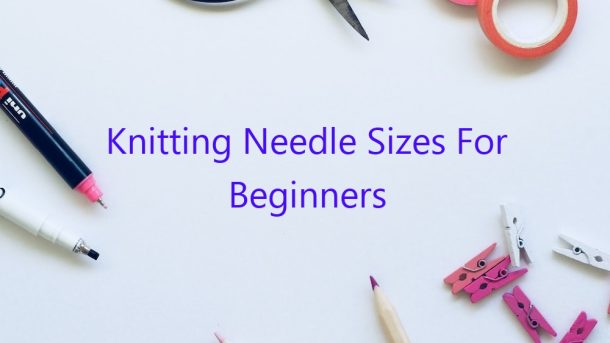When it comes to knitting, needles come in all shapes and sizes. There are so many different types of needles available on the market, it can be hard to decide which one is right for you. In this article, we will discuss the different types of knitting needles, as well as the different sizes and what they are used for.
knitting needles are typically made out of wood, plastic, or metal. They range in size from very small (0-1) to very large (15-19). The size of the needle is important because it determines the size of the stitches that will be created.
There are three main types of knitting needles: straight needles, circular needles, and double-pointed needles.
Straight needles are the most common type of knitting needle. They are straight, long, and thin. They are used to knit flat pieces of fabric, such as scarves, blankets, and sweaters.
Circular needles are used to knit in the round. They are long and thin, with a hooked end. The hooked end is used to join the needles together, allowing you to knit in the round. Circular needles are typically used to knit hats, socks, and sweaters in the round.
Double-pointed needles are used to knit in the round, just like circular needles. However, double-pointed needles have points on both ends, whereas circular needles only have a point on one end. Double-pointed needles are typically used to knit socks, hats, and sleeves in the round.
Now that you know about the different types of knitting needles, let’s discuss the different sizes.
The size of a knitting needle is measured in millimeters. The smallest needles are 0-1 millimeters, and the largest needles are 15-19 millimeters.
The most common needle size is 4 millimeters. This size is used to knit most adult-sized sweaters and accessories.
Most beginners start out with knitting needles that are 6-8 millimeters in size. These needles are large enough to create basic stitches, but small enough to be easy to handle.
If you are knitting a project that requires a very small stitch size, you may need to use a needle that is smaller than 4 millimeters. If you are knitting a project that requires a very large stitch size, you may need to use a needle that is larger than 15 millimeters.
So, what size knitting needle should you use for your project?
The best way to determine the size of needle you need is to read the pattern. The pattern will tell you the size of needle that is required for the project. If you are unable to find the size of needle required in the pattern, you can use the chart below to help you choose the right size needle.
Needle Size Chart
Project Size
Needle Size
0-1
2
3
4
5
6
7
8
9
10
11
12
13
14
15-19
Very Small
Small
Medium
Large
Very Large
Contents
How do I know what size knitting needle to use?
How do I know what size knitting needle to use?
This is a question that a lot of knitters have, and it can be tricky to determine the size needle you need. The two factors to consider are the weight of the yarn you are using and the size of the project you are knitting.
The weight of yarn is measured in ounces, and you can find this information on the yarn label. The thicker the yarn, the heavier it will be. You will need a larger needle for thicker yarn, and a smaller needle for thinner yarn.
The size of the project is also important to consider. A small project, like a hat or a scarf, will require smaller needles than a large project, like a sweater.
There are a few other things to keep in mind when choosing a needle size. If you are a beginner, it might be a good idea to start with a size that is smaller than what you need. This will help you to make sure your stitches are not too loose. You can always go up in needle size if your stitches are too tight.
It is also important to make sure that the needle size is not too small for the yarn you are using. If the needle is too small, the stitches will be too tight and it will be difficult to knit.
So, how do you determine the size needle you need?
The best way to find out is to try a few different sizes. Cast on 20 stitches and knit a few rows in stockinette stitch. If the stitches are too tight, try a larger needle size. If the stitches are too loose, try a smaller needle size.
Once you find a size that works well, stick with that size for the project you are working on. If you are working on a different project, you may need to adjust the needle size depending on the weight of the yarn.
What is the most commonly used knitting needle size?
What is the most commonly used knitting needle size?
The most commonly used knitting needle size is size 7. This size is perfect for creating most projects and is a great all-around size. If you are a beginner, it is recommended that you start with size 7 needles.
What should a beginner knit first?
There are so many different things that a beginner could knit first, it can be overwhelming. So, what should a beginner knit first?
One popular project for a beginner is a scarf. Scarves are a great project because they are simple and can be done in a relatively short amount of time. Plus, they are a great way to practice basic knitting stitches.
Another popular project for a beginner is a hat. Like scarves, hats are simple to knit and can be completed in a relatively short amount of time. Additionally, hats are a great way to practice shaping and knitting in the round.
If you are looking for a project that is a little more challenging, you could try knitting a sweater. Sweaters can be a little more complicated than hats or scarves, but they are definitely doable for a beginner. Plus, knitting a sweater is a great way to practice shaping and increasing and decreasing.
Ultimately, it is up to you what you knit first as a beginner. There are a variety of different projects that are perfect for beginners. So, choose the project that you are most interested in and get started!
Is it easier to knit with big or small needles?
There is no definitive answer to this question as it depends on personal preference. Some knitters find it easier to knit with big needles, while others prefer to use small needles.
One advantage of using big needles is that they move the fabric along more quickly, which can be helpful when knitting a large item. They also create a looser fabric, which some knitters find more comfortable to wear.
Small needles, on the other hand, can be better for intricate knitting patterns and can give a more precise finish. They can also be helpful for beginners, as they are less likely to cause mistakes.
Ultimately, it is up to the individual knitter to decide which size needles work best for them.
What happens if you knit with bigger needles?
What happens if you knit with bigger needles?
One potential outcome of knitting with bigger needles is that your project will come out larger than if you had used smaller needles. This is because the bigger needles allow you to make larger stitches, which means your project will take up more space.
Another potential outcome of using bigger needles is that your project may become more stiff and less flexible. This is because the bigger needles create a denser fabric, which means that the stitches are closer together. This can be desirable if you are looking for a more structured finished product, but it may not be what you are looking for if you are looking for a more stretchy fabric.
Finally, using bigger needles may also cause your project to take longer to complete. This is because the bigger needles create more stitches, and therefore require more time to knit each row.
Is it easier to knit with bigger needles?
Is it easier to knit with bigger needles?
Some knitters believe that it is easier to knit with bigger needles, while others find that using bigger needles makes their knitting project more difficult. There are pros and cons to using either size needle, so it is important to determine what works best for you.
When knitting with smaller needles, the stitches are tighter and more compact. This can be helpful when knitting items that need to be smaller, like socks or hats. Knitting with smaller needles also typically results in a more dense fabric, which can be helpful for projects that need to be warmer or more water resistant.
However, when knitting with smaller needles, it can be more difficult to keep the stitches loose and make sure the fabric is not too tight. This can cause the project to be difficult to knit and can also lead to it being difficult to wear.
When knitting with bigger needles, the stitches are looser and more spread out. This can be helpful when knitting items that need to be bigger, like sweaters or blankets. Knitting with bigger needles typically results in a less dense fabric, which can be helpful for projects that need to be more breathable or less heavy.
However, when knitting with bigger needles, it can be more difficult to keep the stitches tight and make sure the fabric is not too loose. This can cause the project to be difficult to knit and can also lead to it being difficult to wear.
Ultimately, it is up to the knitter to decide what size needles work best for them. Experiment with both sizes and see which provides the best results.
What is the easiest knitting pattern?
If you are new to knitting, you may be wondering what the easiest knitting pattern is. There are a few different options, depending on the type of project you want to make.
If you are looking for a simple project, a scarf or a hat may be the best option. For a scarf, all you need is a piece of yarn and some knitting needles. You can knit a basic scarf by casting on a certain number of stitches, then knitting every row until the scarf is the desired length. For a hat, you will need to cast on more stitches, knit in the round, and decrease the number of stitches as you go.
Another easy knitting pattern is a dishcloth. This is a great project for beginners, as it is a simple and quick knit. All you need is some cotton yarn and Size 7 knitting needles. To make a dishcloth, you will knit a rectangle, then bind off the stitches.
If you are looking for a more challenging project, you may want to try a sweater. However, this is not typically an easy knitting pattern for beginners. Sweaters require a lot of shaping and seaming, which can be difficult for a beginner.
Ultimately, the easiest knitting pattern depends on your skill level and the project you want to make. If you are a beginner, it is best to start with a simple project like a scarf or a dishcloth. Once you have some basic skills, you can move on to more challenging projects.




